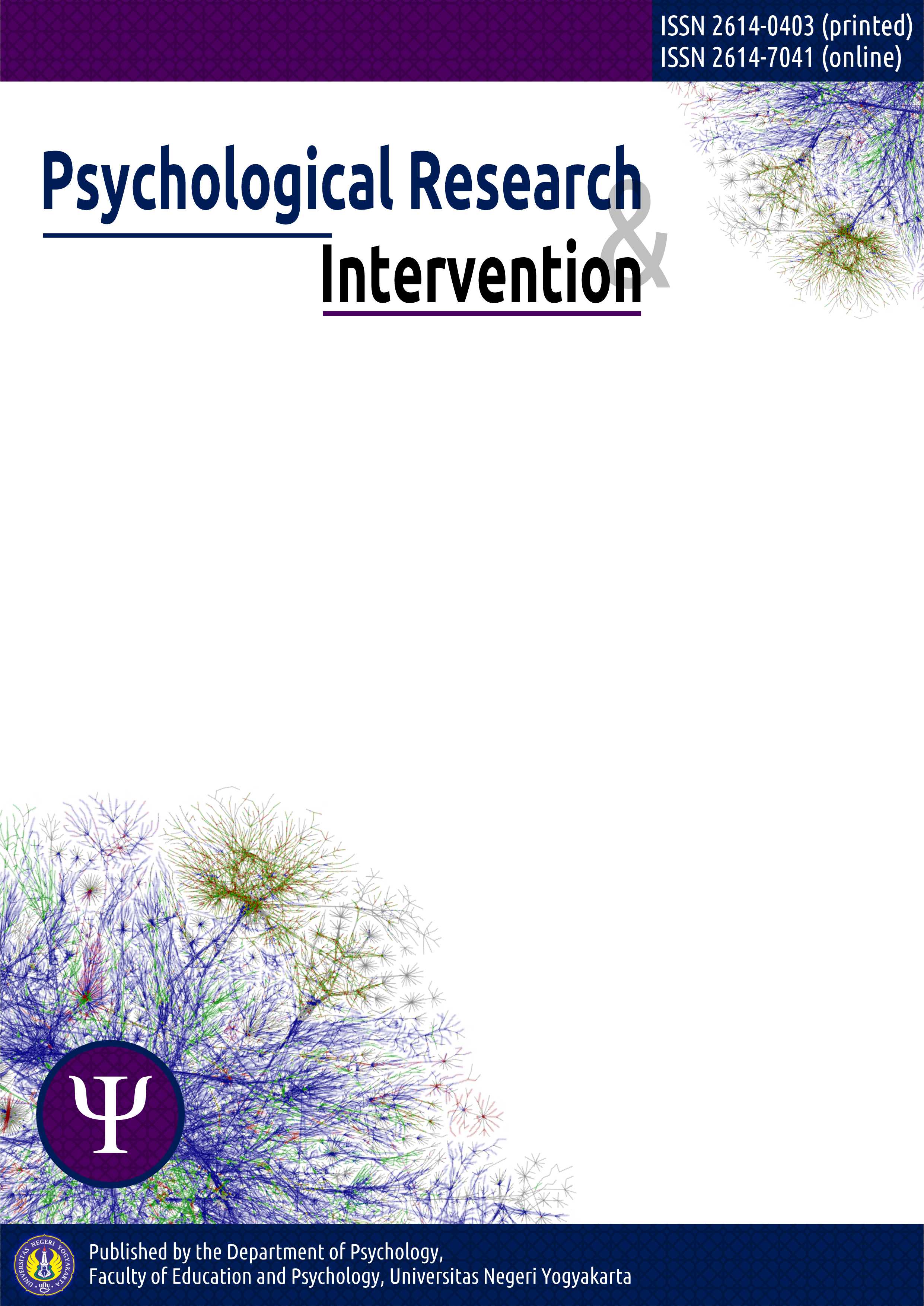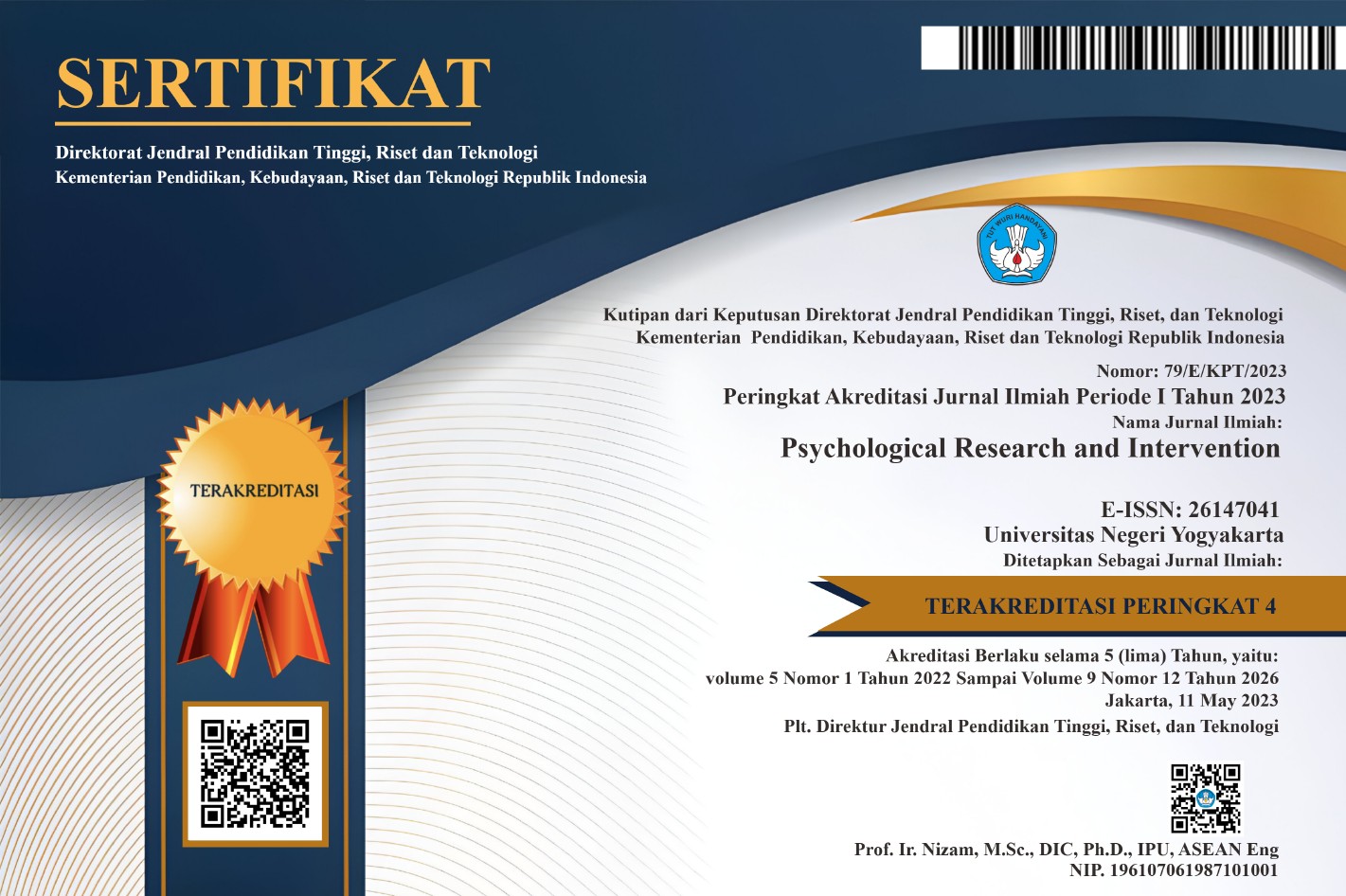Teacher well-being & engagement: The importance of teachers' interpersonal relationships quality at school
DOI:
https://doi.org/10.21831/pri.v6i1.61869Abstract
Relationships are a fundamental feature of human life, making the study of relationships a crucial point in psychology, including within the context of schools. In addition to being a place of learning for students, schools serve as a workplace where teachers establish and maintain relationships. However, the majority of research conducted in schools still focuses only on student-student and teacher-student relationships. Moreover, there is limited specific research examining the importance of the quality of interpersonal relationships among teachers. This quantitative survey study aims to investigate the role of teacher-student interpersonal relationship quality as a predictor of Well-Being within the PERMA framework, encompassing Positive Emotion, Work Engagement, Meaning in Life, and Innovative Work Behavior among teachers in schools. Data were collected through offline and online surveys involving 455 teachers in public schools in Yogyakarta. Data analysis was conducted using Structural Equation Modeling (SEM) to test the model of interpersonal relationships among fellow teachers. The model testing indicated a good fit with the indices: χ2(35, N=455) = 132; p<0.001; CFI = 0.977; SRMR = 0.041; RMSEA = 0.073, meeting the criteria set by Hair, Black, Babin, & Anderson (2019). Furthermore, overall, the quality of teacher-student interpersonal relationships significantly predicted the elements of psychological well-being, including affect (β = 0.631; p < 0.001), meaning in life (β = 0.549, p < 0.001), work engagement (β = 0.489; p < 0.001), and innovative work behavior among teachers in schools (β = 0.354; p < 0.001).
References
Acocella, J. R., & Calhoun, J. F. (1990). Psychology of Adjustment Human Relationship (3rd Ed.). New York: Mcgraw-Hill
Baldwin, A. S., Kiviniemi, M. T., & Snyder, M. (2009). A Subtle Source of Power: The Effect of Having an Expectation on Anticipated Interpersonal Power. The Journal of Social Psychology, 149(1), 82-104. doi:10.3200/SOCP.149.1.82-104
Blau, G. (1994). Developing and testing a taxonomy of lateness behavior. Journal of Applied Psychology, 79(6), 959–970. doi:10.1037/0021- 9010.79.6.959
Bowling, N. A., & Beehr, T. A. (2006). Workplace harassment from the victim's perspective: A theoretical model and meta-analysis. Journal of Applied Psychology, 91(5), 998–1012. https://doi.org/10.1037/0021-9010.91.5.998
Brown, B. B., & Klute, C. (2003). Friendships, cliques, and crowds. In G. R. Adams, & M. D. Berzonsky (Eds.), Blackwell Handbook of Adolescence (pp. 330-348). Malden: Blackwell Publishing. Buechner, V. L., Pekrun, R., & Lichtenfeld, S. (2018). The Achievement Pride Scales (APS). European journal of psychological assessment, 34(3), 181.
Burkett, E. (2002). Another planet: A year in the life of a suburban high school. NewYork: Harper Collins. Butler, J., & Kern, M. L. (2016). The PERMA-Profiler: A brief multidimensional measure of flourishing. International Journal of Wellbeing, 6(3). Breevaart, K., Bakker, A. B., Demerouti, E., & van den Heuvel, M. (2015). Leader member exchange, work engagement, and job performance. Journal of Managerial Psychology. https://doi.org/10.1108/JMP-03-2013- 0088
Chris Segrin; Melissa Taylor (2007). Positive interpersonal relationships mediate the association between social skills and psychological well-being. , 43(4), 637–646. doi:10.1016/j.paid.2007.01.017
Collins, W. A., & Steinberg, L. (2006). Adolescent Development in Interpersonal Context. In W. Damon, & R. Lerner (Eds.), Handbook of Child Psychology (6th ed.). New York: Wiley.
Combette, L. T., Camenen, E., Rotge, J. Y., & Schmidt, L. (2021). Identified Motivation as a Key Factor for School Engagement During the COVID-19 Pandemic-Related School Closure. Frontiers in psychology, 12, 752650-752650.
Cuadros, O. & Berger, C. (2016). The Protective Role of Friendship Quality on the Wellbeing of Adolescents Victimized by Peers. Journal of Youth and Adolescence, 45, 1877–1888. https://doi.org/10.1007/s10964-016-0504-4
Deci, E. L., Connell, J. P., & Ryan, R. M. (1989). Self-determination in a work organization. Journal of applied psychology, 74(4), 580.
Downie, M., Mageau, G. A., & Koestner, R. (2008). What Makes for a Pleasant Social Interaction? Motivational Dynamics of Interpersonal Relations. The Journal of Social Psychology, 148(5), 523-534. doi:10.3200/SOCP.148.5.523-534
Faturochman, Faturochman & Nurjaman, Tabah. (2018). Pendahuluan - Relasi Sosial.
Garcia-Esquinas, E., Ortol,á, R., Gine-Vazquez, I., Carnicero, J. A., Manas, A., Lara, E., et al. (2021). Changes in health behaviors, mental and physical health among older adults under severe lockdown restrictions during the COVID-19 pandemic in Spain. medRxiv. 18:7067. doi: 10.3390/ijerph18137067
Gilbert, K. L., Quinn, S. C., Goodman, R. M., Butler, J., & Wallace, J. (2013). A meta-analysis of social capital and health: A case for needed research. Journal of Health Psychology, 18(11), 1385–1399
Gong, S., Xu, P., Wang, S. (2021). Social Capital and Psychological Well-Being of Chinese Immigrants in Japan. International Journal of Environmental Research and Public Health 18, 1- 12
Hartup, W., & Stevens, N. (1997). Friendships and Adaptation in the Life Course. Psychological Bulletin, 121(3), 355-370. https://doi.org/10.1037/0033-2909.121.3.355
Holt-Lunstad, J., Smith, T. B., & Layton, J. B. (2010). Social relationships and mortality risk: A metaanalytic review. PLOS Medicine, 7(7), Article e1000316. doi:10.1371/journal.pmed.100031
Jacobs, S., Renard, M., & Snelgar, R. J. (2014). Intrinsic rewards and work engagement in the South African retail industry. SA Journal of Industrial Psychology. https://doi.org/10.4102/sajip.v40i2.1195
Kelley, H. H. (1983). Analyzing Close Relationships. In H. H. Kelley, E. Berscheid, A. Christensen, J. H. Harvey, T. L. Huston, G. Levinger, . . . D. R. Peterson (Eds.), Close Relationships. New York: W. H. Freeman.
Kim, T. G., Lee, J. K., & Lee, J. H. (2013). Do interpersonal relationships still matter for turnover intention? A comparison of South Korea and China. The International Journal of Human Resource Management, 24(5), 966-984. doi:10.1080/09585192.2012.743472
Kusmaryani, R. E., Nurhayati, S. R. & Wicaksono, B. (2020). "Dinamika Relasi Pada Guru: Studi Relasi Guru Dengan Siswa, Relasi Antar Guru, Dan Guru Dengan Kepala Sekolah". Laporan Penelitian
Lawler, E. J., Thye, S. R., & Yoon, J. (2006). Commitment in structurally enabled and induced exchange relations. Social Psychology Quarterly, 69(2), 183-200. doi:10.1177/019027250606900204
Manstead, A. S., Hewstone, M., Fiske, S. T., Hogg, M. A., Reis, H. T., & Semin, G. R. (Eds.). (1996). The Blackwell Encyclopedia of Social Psychology. : . Oxford: Blackwell Publishers Ltd
Newman, B. M., Newman, P. R., Griffen, S., O'Connor, K., & Spas, J. (2007). The relationship of social support to depressive symptoms during the transition to high school. Adolescence, 42(167), 441–459.
O'Rourke, J., Harms, C. & Cohen, L. (2019). They're always there for me! Friendship and meaning in young people's lives?. Scandinavian Journal of Psychology, 60, 596– 608. OCED (2013). OECD Guidelines on Measuring Subjective well-being. OECD Publishing.
Orbuch, T. L., & Sprecher, S. (2003). Attraction and interpersonal relationships. In J. Delamater (Ed.), Handbooks of sociology and social research: Handbook of social psychology (pp. 339–362). Kluwer Academic/Plenum Publishers.
OCED (2013). OECD Guidelines on Measuring Subjective well-being. OECD Publishing. Orbuch, T. L., & Sprecher, S. (2003). Attraction and interpersonal relationships.
Park, N., Peterson, C., and Seligman, M. E. P. (2006). Character strengths in fifty-four nations and the fifty US states. J. Posit. Psychol. 1, 118–129. doi: 10.1080/17439760600619567
Peterson, C., & Seligman, M. E. (2004). Character strengths and virtues: A handbook and classification (Vol. 1). Oxford University Press.
Reis, H. T., Collins, W. A., & Berscheid, E. (2000). The relationship context of human behavior and development. Psychological Bulletin, 126(6), 844- 872.
Reich, T., & Hershcovis, S. (2011). Interpersonal relationships at work. Research Gate. University of Manitoba. https://www.researchgate.net/publication/261992861_Interpersonal_relationships_at_work
Ryff, C. D., and Keyes, C. L. M. (1995). The structure of psychological well-being revisited. J. Pers. Soc. Psychol. 69, 719–727. doi: 10.1037/0022-3514.69.4.719
Ryff, C. D., & Singer, B. (2000). Interpersonal flourishing: A positive health agenda for the new millennium. Personality and social psychology review, 4(1), 30-44
Ryff, C. D., Singer, B. H., Wing, E., & Love, G. D. (2001). Elective affinity and uninvited agonies: mapping emotion with significant others onto health. In C. D. Ryff & B. H. Singer (Eds.), Emotion, social relationships, and health (pp. 133–175). New York: Oxford University Press.
Santrock, J. W. (2012). A Topical Approach to Life-Span Development (6th ed.). New York: McGraw-Hill International Edition
Schaufeli, W. B., Bakker, A. B., & Salanova, M. (2003). Utrecht work engagement scale-9. Educational and Psychological Measurement.
Schaufeli, W., & Salanova, M. (2007). Work engagement. Managing social and ethical issues in organizations, 135, 177
Schulenberg, S. E., Strack, K. M., & Buchanan, E. M. (2011). The Meaning in Life Questionnaire: Psychometric properties with individuals with serious mental illness in an inpatient setting. Journal of clinical psychology, 67(12), 1210-1219
Segrin, C. (2001). Interpersonal processes in psychological problems. Mahwah, NJ: Lawrence Erlbaum
Seligman, M. E. P. (2013). Flourish. New York, NY: Atria
Shahar, G., Cohen, G., Grogan, K. E., Barile, J. P., and Henrich, C. C. (2009). Terrorism-related perceived stress, adolescent depression, and social support from friends. Pediatrics 124, e235– e240. doi: 10.1542/peds.2008-2971
Skrypnek, B. J., & Snyder, M. (1982). On the self-perpetuating nature of stereotypes about women and men. Journal of Experimental Social Psychology, 18(3), 277-291. doi:10.1016/0022-1031(82)90054-3
Spilt, J. L., Hughes, J. N., Wu, J. Y., & Kwok, O. M. (2012). Dynamics of TeacherStudent Relationships: Stability and Change across Elementary School and the Influence on Children's Academic Success. Child Development, 83(4), 1180-1195. doi:10.1111/j.1467- 8624.2012.01761.x
Taylor, S. E., Peplau, L. A., & Sears, D. O. (2006). Social Psychology (12th ed.). New Jersey: Pearson.
Thoits, P. A. (2011). Mechanisms linking social ties and support to physical and mental health. Journal of Health and Social Behavior, 52, 145–161. Tov, W. (2018). Well-being concepts and components. In E. Diener, S. Oishi, & L.
Tay (Eds.), Handbook of well-being. Salt Lake City, UT: DEF Publishers. DOI:nobascholar.comUchino, B. N. (2009). Understanding the links between social support and physical health: A lifespan perspective with emphasis on the separability of perceived and received support. Perspectives on Psychological Science, 4, 236–255
Van Droogenbroeck, F., Spruyt, B., & Vanroelen, C. (2014). Burnout among senior teachers: Investigating the role of workload and interpersonal relationships at work. Teaching and teacher education, 43, 99-109
Vera, M., Martínez, I., Lorente, L., & Chambel, M. (2016). The Role of Coworker and Supervisor Support in the Relationship Between Job Autonomy and Work Engagement Among Portuguese Nurses: A Multilevel Study. Social Indicators Research, 126(3), 1143-1156. doi:10.1007/s11205-015-0931-8
Watson, D., Clark, L. A., & Tellegen, A. (1988). Development and validation of brief measures of positive and negative affect: the PANAS scales. Journal of personality and social psychology, 54(6), 1063
Yamaguchi, A. (2013). Influences of Social Capital on Health and Well Being from Qualitative Approach. Global Journalof Health Science; 5(5), 153-161. https://doi.org/10.1177/135910531143598
Yu, E. A., & Chang, E. C. (2021). Relational meaning in life as a predictor of interpersonal well-being: A prospective analysis. Personality and Individual Differences, 168, 110377. doi:10.1016/j.paid.2020.11












